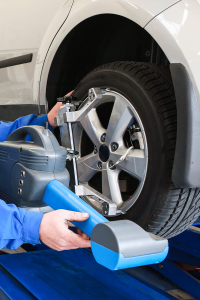
Regular tire inspections are important to help improve the safety and efficiency of your vehicle. The main functions of a vehicle’s tires include supporting the vehicle load, transmitting traction and braking forces to the road surface, absorbing road shocks, and changing and maintaining the direction of travel. To ensure these functions are being adequately met, there are some important things to inspect on each of your vehicle’s tires on a regular basis, including the tread depth of your tires, the wear, the air pressure, and any damage or signs of deterioration. By making sure to have regular tire inspections, you can improve the overall efficiency.
Tread depth is essential to a well-performing tire. Water accumulates on the road during wet conditions. Tires need tread for better traction during these harsh conditions. The grooves on your tires work to siphon water away from the surface of the tires when the road is wet. If the tread on the tires is not at the proper depth, it can become difficult for enough water to be carried out from beneath the tires, thus increasing the possibility that you could lose control of the vehicle. When a vehicle is traveling too fast, or the tire treads are not able to channel enough water out from beneath the tire, hydroplaning may occur. Hydroplaning is when your vehicle’s tires lose contact with the road and skim across a thin layer of water instead, causing a loss of control of the vehicle.
Your tires have an air pressure specification. If they are over or under-inflated your tires will suffer, as will your gas mileage and driving maneuverability. A quality tire air pressure gauge is all you need to inspect your tire air pressure. The pressure gauge will allow you to measure the pounds per square inch (PSI) of each of your tires and make sure they are inflated to the manufacturer’s recommended pressure. Maintaining the correct pressure will ensure better fuel economy, and your vehicle will be a much safer and more comfortable driving machine. You should never try to visually estimate the inflation pressure of your tires. Always use a tire pressure gauge.
Over-inflated tires become rigid and stiff, causing the tire’s contact patch, the amount of rubber that touches the road, to be reduced. This leads to a less comfortable ride, as well as uneven tread wear. Under-inflated tires have adverse effects, as well. Under-inflated tires do not hold their shape and are flatter to the ground. Therefore, more of the tire’s surface touches the road, causing the shoulders of the tire to wear prematurely.




Recent Comments